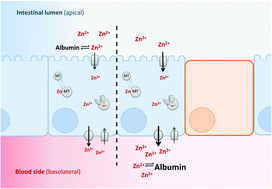当前位置:
X-MOL 学术
›
Metallomics
›
论文详情
Our official English website, www.x-mol.net, welcomes your feedback! (Note: you will need to create a separate account there.)
The impact of apical and basolateral albumin on intestinal zinc resorption in the Caco-2/HT-29-MTX co-culture model†
Metallomics ( IF 3.4 ) Pub Date : 2018-06-13 00:00:00 , DOI: 10.1039/c8mt00064f Maria Maares 1, 2, 3, 4, 5 , Ayşe Duman 1, 2, 3, 4, 5 , Claudia Keil 1, 2, 3, 4, 5 , Tanja Schwerdtle 5, 6, 7, 8, 9 , Hajo Haase 1, 2, 3, 4, 5
Metallomics ( IF 3.4 ) Pub Date : 2018-06-13 00:00:00 , DOI: 10.1039/c8mt00064f Maria Maares 1, 2, 3, 4, 5 , Ayşe Duman 1, 2, 3, 4, 5 , Claudia Keil 1, 2, 3, 4, 5 , Tanja Schwerdtle 5, 6, 7, 8, 9 , Hajo Haase 1, 2, 3, 4, 5
Affiliation

|
The molecular mechanisms of intestinal zinc resorption and its regulation are still topics of ongoing research. To this end, the application of suitable in vitro intestinal models, optimized with regard to their cellular composition and medium constituents, is of crucial importance. As one vital aspect, the impact of cell culture media or buffer compounds, respectively, on the speciation and cellular availability of zinc has to be considered when investigating zinc resorption. Thus, the present study aims to investigate the impact of serum, and in particular its main constituent serum albumin, on zinc uptake and toxicity in the intestinal cell line Caco-2. Furthermore, the impact of serum albumin on zinc resorption is analyzed using a co-culture of Caco-2 cells and the mucin-producing goblet cell line HT-29-MTX. Apically added albumin significantly impaired zinc uptake into enterocytes and buffered its cytotoxicity. Yet, undigested albumin does not occur in the intestinal lumen in vivo and impairment of zinc uptake was abrogated by digestion of albumin. Interestingly, zinc uptake, as well as gene expression studies of mt1a and selected intestinal zinc transporters after zinc incubation for 24 h, did not show significant differences between 0 and 10% serum. Importantly, the basolateral application of serum in a transport study significantly enhanced fractional apical zinc resorption, suggesting that the occurrence of a zinc acceptor in the plasma considerably affects intestinal zinc resorption. This study demonstrates that the apical and basolateral medium composition is crucial when investigating zinc, particularly its intestinal resorption, using in vitro cell culture.
中文翻译:

在Caco-2 / HT-29-MTX共培养模型中,顶端和基底外侧白蛋白对肠道锌吸收的影响†
肠道锌吸收及其调控的分子机制仍然是正在进行的研究的主题。为此,适合体外应用在细胞组成和培养基成分方面进行了优化的肠道模型至关重要。作为一个重要方面,在研究锌的吸收时,必须考虑细胞培养基或缓冲液化合物分别对锌的形态和细胞利用率的影响。因此,本研究旨在研究血清,尤其是其主要成分血清白蛋白对肠道细胞系Caco-2中锌吸收和毒性的影响。此外,使用Caco-2细胞和产生粘蛋白的杯状细胞系HT-29-MTX的共培养分析了血清白蛋白对锌吸收的影响。根尖添加白蛋白会显着损害肠细胞对锌的吸收,并缓冲其细胞毒性。然而,未消化的白蛋白不会在肠腔中发生在体内,白蛋白的消化消除了锌摄取的障碍。有趣的是,锌孵育24小时后,锌的吸收以及mt1a和选定的肠道锌转运蛋白的基因表达研究在0%和10%的血清之间没有显着差异。重要的是,在运输研究中血清的基底外侧应用显着增强了部分根尖锌的吸收,这表明血浆中锌受体的出现大大影响了肠道锌的吸收。这项研究表明,使用体外细胞培养技术研究锌,尤其是肠道吸收时,根尖和基底外侧成分至关重要。
更新日期:2018-06-13
中文翻译:

在Caco-2 / HT-29-MTX共培养模型中,顶端和基底外侧白蛋白对肠道锌吸收的影响†
肠道锌吸收及其调控的分子机制仍然是正在进行的研究的主题。为此,适合体外应用在细胞组成和培养基成分方面进行了优化的肠道模型至关重要。作为一个重要方面,在研究锌的吸收时,必须考虑细胞培养基或缓冲液化合物分别对锌的形态和细胞利用率的影响。因此,本研究旨在研究血清,尤其是其主要成分血清白蛋白对肠道细胞系Caco-2中锌吸收和毒性的影响。此外,使用Caco-2细胞和产生粘蛋白的杯状细胞系HT-29-MTX的共培养分析了血清白蛋白对锌吸收的影响。根尖添加白蛋白会显着损害肠细胞对锌的吸收,并缓冲其细胞毒性。然而,未消化的白蛋白不会在肠腔中发生在体内,白蛋白的消化消除了锌摄取的障碍。有趣的是,锌孵育24小时后,锌的吸收以及mt1a和选定的肠道锌转运蛋白的基因表达研究在0%和10%的血清之间没有显着差异。重要的是,在运输研究中血清的基底外侧应用显着增强了部分根尖锌的吸收,这表明血浆中锌受体的出现大大影响了肠道锌的吸收。这项研究表明,使用体外细胞培养技术研究锌,尤其是肠道吸收时,根尖和基底外侧成分至关重要。



























 京公网安备 11010802027423号
京公网安备 11010802027423号